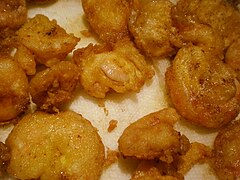Philippine shrimp dish
Camaron rebosado Alternative names Camarón rebozado Rebosadong hipon [ 1] Course Main dish Place of origin Philippines Serving temperature Hot Main ingredients shrimp, batter Variations Camarón rebozado con jamon
Camaron rebosado battered shrimp dish in Philippine cuisine . It is usually served with a sweet and sour sauce . It is a common dish in Philippine cuisine.[ 2]
Etymology
The term camaron rebosado comes from the Spanish phrase camarón rebozado seseo Spanish spoken at the time of its introduction , the latter part of the phrase was pronounced as a homophone of rebosado kamaron rebosado [ 3] Chinese Filipino , originally introduced by Chinese migrants to the Philippines.[ 2] [ 4]
Preparation
Camaron rebosado being fried Camaron rebosado is prepared by removing the heads, and sometimes the tails as well, of the shrimp.[ 5] [ 6] [ 7] calamansi juice, salt, black pepper , garlic, and other spices to taste. The batter is made by mixing flour with egg, black pepper, corn starch or baking powder , and water.[ 7] [ 8] [ 6] [ 4] [ 7] [ 8] bread crumbs before frying.[ 9] [ 10]
Camaron rebosado is traditionally served with sweet and sour sauce (agre dulce ).[ 9] [ 11] dipping sauce .[ 12] soy sauce and calamansi juice (toyomansi tomato and banana ketchup .[ 13] [ 2] [ 8]
Camaron rebosado is similar to Japanese tempura , although tempura uses a lighter batter that is chilled before frying.[ 14] [ 13]
Variations
Camaron rebosado con jamon (also spelled camaron rebosado con hamon ) is a variation of the dish that includes ham wrapped around the shrimp in its preparation.[ 15] [ 16] Binondo district of Manila , the city's Chinatown .[ 17]
See also
References
^ "Camaron Rebosado" . Mama's Guide Recipes . July 15, 2017. Archived from the original on March 31, 2022. Retrieved December 16, 2018 .^ a b c Garcia, M.; Tettoni, L. (2012). Filipino Cookbook: 85 Homestyle Recipes to Delight Your Family and Friends ISBN 978-1-4629-0528-7 ^ Polistico, Edgie (2017). Philippine Food, Cooking, & Dining Dictionary ISBN 9786214200870 ^ a b Diego, A. (2011). Step by Step Cooking Filipino: Delightful Ideas for Everyday Meals ISBN 978-981-4435-15-4 ^ Basbas, E.A. Learning & Living in the 21st Century i for H.s.' 2007 Ed ISBN 978-971-23-4784-9 ^ a b Alcuaz, N.T. (2005). Banana Leaves: Filipino Cooking and Much More ISBN 978-1-4120-5378-5 ^ a b c "Camaron Rebosado" . Kawaling Pinoy . February 21, 2014. Archived from the original on May 14, 2021. Retrieved December 16, 2018 .^ a b c Agbanog, Liza (July 6, 2016). "Camaron Rebosado (Deep Fried Battered Prawns)" . Salu Salo Recipes . Archived from the original on March 18, 2022. Retrieved December 16, 2018 . ^ a b Dagoon, E.A. Culinary Arts i ISBN 978-971-23-2603-5 ^ Fernando, E.A. New Perspectives in English One' 2005 Ed ISBN 978-971-23-4249-3 ^ Alejandro, R.; Tettoni, L. (2012). Authentic Recipes from the Philippines ISBN 978-1-4629-0533-1 ^ Olizon-Chikiamco, N. (2003). Homestyle Filipino Cooking ISBN 978-1-4629-1392-3 ^ a b Alejandro, R.G. (1985). The Philippine Cookbook ISBN 978-0-399-51144-8 ^ Fernandez, Doreen ; Edilberto N. Alegre (1988). Sarap: Essays on Philippine food 145 . ISBN 978-971-91137-0-6 ^ Panlilio, E.E. (2003). Comfort Food ISBN 978-971-27-1407-8 ^ Reyes, C.; Fernando, G.C. (1991). Kusina: what's cooking in the Philippines ^ Perez, Irene C. (February 16, 2012). "Camaron Rebosado con Jamon and other 'mestizong Intsik' favorites" . Philippine Daily Inquirer Archived from the original on April 22, 2016. Retrieved April 7, 2016 .
External links



